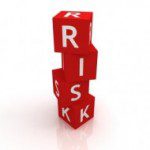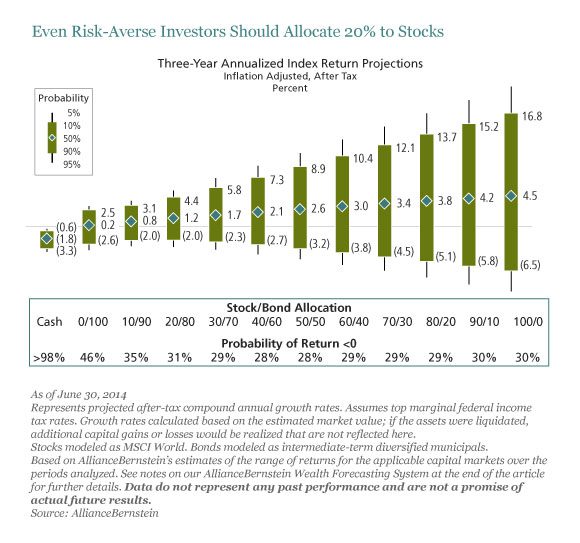Many investors with little appetite for risk think cash is the safest asset class but  there’s a much better way to control risk than keeping all your money in cash or bonds: diversifying through a modest addition of stock to the mix. How much should be in stocks? Read on!
there’s a much better way to control risk than keeping all your money in cash or bonds: diversifying through a modest addition of stock to the mix. How much should be in stocks? Read on!
The above introductory comments are edited excerpts from an article* by Seth Masters & John McLaughlin (blog.alliancebernstein.com) entitled What’s the Safest Investment Strategy?.
Masters & McLaughlin go on to say in further edited excerpts:
If you have no investments, you have no investment risk…but it’s reassuring only if you ignore inflation and taxes and of course, most individuals do pay taxes and everyone experiences inflation. Take inflation and taxes into account, and investors holding nothing but cash are virtually certain to be poorer in real terms three years from now.
An all-bond portfolio is a somewhat better proposition, but it, too, could well lose purchasing power in the market environment we anticipate. Unfortunately, no portfolio is completely safe after taxes and inflation.
Fortunately, there is a much better way to control risk than keeping all your money in cash or bonds: diversifying through a modest addition of stock to the mix. By our calculation, even the most risk-averse investors should hold at least 20% of their portfolios in stocks—assuming that they don’t have large bills to pay in the very near term.
The table below shows how we came to this conclusion. Using our Wealth Forecasting System, we projected annualized three-year returns for portfolios with a range of asset allocations.
- In typical markets, after inflation and taxes, we forecast that an all-cash portfolio (on the extreme left) will lose 1.8% a year.
- In great markets, it will lose 0.6%, and
- in hostile markets, the losses will mount to 3.3% a year.
For all these forecasts, we’ve assumed a US investor in the highest federal tax bracket.
 Directly to the right of the all-cash portfolio, you can see that we expect an all-bond portfolio to deliver
Directly to the right of the all-cash portfolio, you can see that we expect an all-bond portfolio to deliver
- 0.2% a year in typical markets,
- 2.5% in great markets and
- (2.6)% in hostile markets.
In comparison to the all-cash and all-bond choices, we predict that an all-stock portfolio (on the extreme right) will deliver a lot more in typical and great markets, but also lose more in hostile markets, yielding returns of (6.5)% annualized. This may seem very mild compared to memories of 2008, but in fact, annualized returns for the three years from 2007 to 2009 were not a great deal worse: (7.2)%. Our analysis indicates that the probability of another loss this large is less than 10%.
Between the all-bond and the all-stock portfolios, we’ve estimated the range of returns you are likely to experience across the full spectrum of diversified portfolios.
Conclusion
For a taxable investor whose primary goal is minimizing the risk of real losses, the 20/80 asset mix offers better returns than the all-cash or all-bond portfolio in positive market environments and smaller losses when market returns are negative. To the right of the 20/80 portfolio, the more stock exposure you add, the better you do when markets are typical or better, but the worse you do when market returns are poor.
Fear (and greed) can prompt investors to make irrational choices. Cash feels safe, but a closer look shows otherwise. Risk-averse investors who can overcome their emotional bias against owning any stock can improve their returns and reduce their real downside risk.
Editor’s Note: The author’s views and conclusions in the above article are unaltered and no personal comments have been included to maintain the integrity of the original post. Furthermore, the views, conclusions and any recommendations offered in this article are not to be construed as an endorsement of such by the editor.
*http://blog.alliancebernstein.com/index.php/2014/09/17/whats-the-safest-investment-strategy/ (© 2014 AllianceBernstein L.P.)
Related Articles:
1. What Could Possibly Be A Better Safe Haven Than Gold? Read On
Some market commentators are touting gold as a great portfolio diversifier, convincing investors that the precious metal could benefit their portfolio but there may be better alternatives than gold if the motivation is to find a hedge for economic uncertainty or political unrest. Read More »
2. Where Should Your Money Be In This “No Safe Haven Era”?
How have the traditional safe havens performed since the great financial crash of 2008/2009? What can we expect from the traditional safe havens going forward? Those are the two questions we try to answer in this article. Read More »
 munKNEE.com Your Key to Making Money
munKNEE.com Your Key to Making Money


